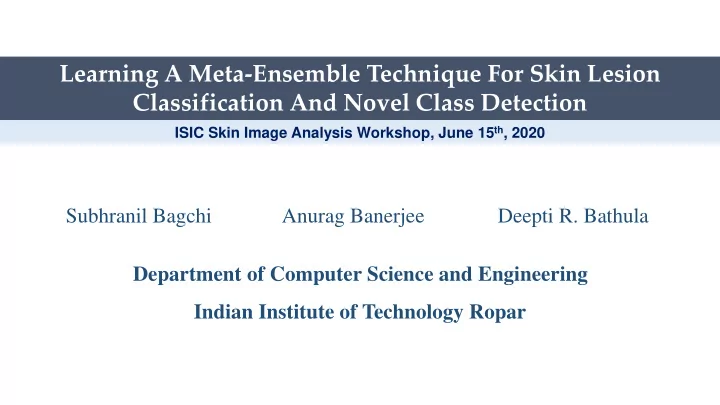

Learning A Meta-Ensemble Technique For Skin Lesion Classification And Novel Class Detection ISIC Skin Image Analysis Workshop, June 15 th , 2020 Subhranil Bagchi Anurag Banerjee Deepti R. Bathula Department of Computer Science and Engineering Indian Institute of Technology Ropar
Problem Statement • The ISIC Challenge 1 • Predicting Images of Categories: Melanoma, Melanocytic nevus, Basal cell carcinoma, Actinic keratosis, Benign keratosis, Dermatofibroma, Vascular lesion, Squamous cell carcinoma, None of the others • Motivation • Our approach: Two-level hierarchical model 2 1. Homepage of ISIC 2019 Challenge: https://challenge2019.isic-archive.com/
Challenges with the ISIC 2019 Dataset • Multi-source acquisition • High-dimensional, low sample-space (25,331 images) • Eight training classes with disproportionate samples: MEL (4,522), NV (12,875), BCC (3,323), AK (867), BKL (2,624), DF (239), VASC (253), SCC (628) • Test time Novelty detection Figure: Per-class histogram depicting class imbalance for ISIC 2019 Dataset 1,2,3 1. “The HAM10000 dataset, a large collection of multi-source dermatoscopic images of common pigmented skin lesions”, Tschandl et. al. (2018) 2. “ Skin Lesion Analysis Toward Melanoma Detection: A Challenge at the 2017 International Symposium on Biomedical Imaging (ISBI), Hosted by the International Skin Imaging Collaboration (ISIC )”, Codella et. al. (2017) 3 3. “ BCN20000: Dermoscopic Lesions in the Wild”, Combalia et. al. (2019)
Preprocessing Source ISIC 2019 Dataset Figure: Raw Images Figure: Images after preprocessing using Shades of Gray 1 4 1. “Shades of Gray and Color Constancy”, Finlayson et. al. (2004)
Stacking Module • Pre-trained Base learners: • EfficientNet-B2 1 • EfficientNet-B5 1 ( two configurations ) • DenseNet-161 2 • Meta-learner (stack of base-learners) • Data Augmentation • Trained with Figure: Stacking Module Weighted Cross-Entropy loss • Ensemble of cross-validated models. 1. “ EfficientNet: Rethinking Model Scaling for Convolutional Neural Networks”, Tan et. al. (2019) 5 2. “Densely Connected Convolutional Networks”, Huang et. al. (2017)
Model Configuration Table: Base Learners’ input configurations for Images 6
Stacking Module - Training Process { Stratified Folds 7
Stacking Module - Training Process 8
Stacking Module - Training Process 9
Stacking Module - Training Process 10
Stacking Module - Training Process 11
Stacking Module - Training Process { Stratified Folds 12
Stacking Module - Training Process 13
t-SNE Plots Figure: t-SNE 1,2 plot for Average Model on Validation Set- 4.2 Figure: t-SNE plot for Stack Model on Validation Set- 4.2 1. “Visualizing Data using t- SNE”, Maaten et. al. (2008) 14 2. “GPU Accelerated t-distributed Stochastic Neighbor Embedding”, Chan et. Al. (2019)
t-SNE Plots (Cont.) Figure: t-SNE plot for Average Model on Validation Set- 2.2 Figure: t-SNE plot for Stack Model on Validation Set- 2.2 15
Class Specific – Known vs. Simulated Unknown Modules (CS-KSU) • Class-wise individual modules ( one vs. rest ) • Trained for multiple folds, ( with simulated unknowns ) • ResNet-18 1 • Data Augmentation • Trained with Weighted Cross-Entropy and Triplet Loss • Prediction average • Thresholding 16 1. “Deep Residual Learning for Image Recognition”, He et. al. (2016)
Class Specific – Known vs. Simulated Unknown Modules – The Splits • Trained with leave-one- unknown-class -out, one- versus -rest cross validation 7 Combinations for the Simulated Unknown Class Set and Validation Set e.g. {C2 b , C3 b , …, C8 b } { C7 b , C1 b } 7 Combinations for the Simulated Unknown Class Set and Validation Set e.g. {C2 a , C3 a , …, C8 a } { C7 a , C1 a } Known Simulated Validation Set Class (C1) Unknown Set Class Set 17
Class Specific – Known vs. Simulated Unknown Modules – The Splits A Fold-set Known Simulated Validation Set Class (C1) Unknown Set Class Set 18
Class Specific – Known vs. Simulated Unknown Modules – Training Process 14 Models per Known Class (i.e., per CS-KSU Module) 19
Class Specific – Known vs. Simulated Unknown Modules – Training Process 20
Thresholding Explained 21
Choice for Cost Functions Weighted Cross Entropy Loss 1 • Deals with imbalanced class distribution 22 1. “The Real-World-Weight Cross-Entropy Loss Function: Modeling the Costs of Mislabeling ”, Ho et. al. (2020)
Choice for Cost Functions Triplet Loss 1 • Reduces distance between same class samples, whereas broadens otherwise • Useful for margin in latent space between known and simulated unknowns 23 1. “ FaceNet: A Unified Embedding for Face Recognition and Clustering”, Scroff et. al. (2015)
Testing Process – Complete Model Figure: Diagram explaining the testing procedure 24
Testing Process – Explained 25
Testing Process – Explained 26
Testing Process – Explained 27
Testing Process – Explained 28
Testing Process – Explained 29
Results Table 2: Class-wise AUC 2 score of our Table 1: Comparison with few other results from ISIC 2019 Live Leaderboard 1 different models 1. Our results stated, as compared on the ISIC Live Leaderboard 2019: Lesion Diagnosis only . URL: https://challenge2019.isic-archive.com/live-leaderboard.html 30 2. “ The Meaning and Use of the Area Under a Receiver Operating Characteristic (ROC) Curve ”, Hanley et. al. (1982)
ROC Plots Figure: ROC plot for Average Model 1 Figure: ROC plot for Stack Model 1 Figure: ROC plot for Stack plus CS-KSU Model 1 31 1. Source ISIC Live Leaderboard 2019: Lesion Diagnosis. URL: https://challenge2019.isic-archive.com/live-leaderboard.html
Summary and Discussion • A two-level hierarchical model was proposed in the work • Stacking performs better than simple averaging, whereas CS-KSU module looks promising • The hierarchical model is difficult to scale with increase in number of classes • Trade off between AUC for Unknown class and BMA indicates the difficulty of the challenge • The model’s performance may improve with extra data 32
Thank you! 33
Recommend
More recommend